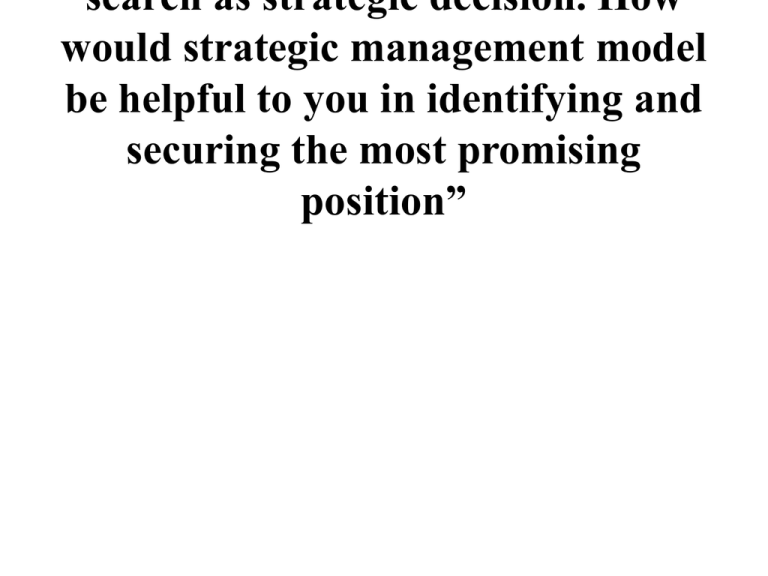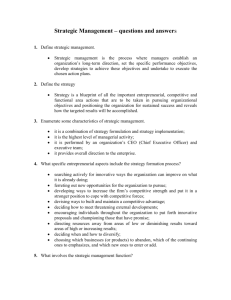Think of your post graduation job search as strategic decision. How
advertisement

search as strategic decision. How would strategic management model be helpful to you in identifying and securing the most promising position” managing the pursuit of organizational mission while managing the relationship of the organization to its environment (James M. Higgins). the formulation and implementation of strategies designed to achieve the objectives of the organization (John A. Pearce II and Richard B. Robinson, Jr.). organization's objectives, and making, implementing, and controlling decisions focused on achieving these objectives in the present and future environments(Garry D. Smith, Danny R. Arnold, Bobby G. Bizzell). process that involves attempts to match or fit the organization with its changing environment in the most advantageous way possible (Lester A. Digman). management is the process of determining the future direction of the organization and implementing decision that aim at achieving the organization strategic objectives. strategic management model, a number of steps are taken to achieve the objectives of a company. Different strategic management models are chosen by various companies according to their conveniences. – About strategic management model Strategic management model is also known as strategic planning model. A strategic planning model is selected for the purpose of formulating and implementing the strategic management plan of a particular organization. Nevertheless, it has been proved that no strategic planning model is perfect. Every company designs its own strategic planning model frequently by choosing a model and transforming it as the company advances into formulating its strategic management plan procedures. A number of strategic planning model options are available for the companies from which they can choose. – The components of a strategic management model In the decade of 1970s, a large number of corporations followed a recognized strategic planning model, which is top down in nature. According to this model, strategic planning was a calculated procedure where the top management would design the strategy of the company and after that it was passed on downward in the company for application. The steps involved in this strategic planning model were the following: Mission Often, the organization's mission is defined in a formal, written mission statement. Decisions or mission are the most important strategic decisions, because the mission is meant to guide the entire organization. Although the terms "purpose" and "mission" are often used interchangeably, to distinguish between them may help in understanding organizational goals. Objectives points of an organization's mission. Objectives refer to the specific kinds of results the organizations seek to achieve through its existence and operations(William F. Glueck, and Lawrence R. Jauch) Objective define what it is the organization hopes to accomplish, both over the long and short term. Strategies that the basic objectives of the enterprise are achieved through proper execution by the organization" (William F. Glueck, and Lawrence R. Jauch). Strategy formulation is the process of establishing the organization's mission, objectives, and choosing among alternative strategies. Sometimes strategy formulation is called "strategic planning Situation Analysis (internal and external) Analysis) and SWOT Analysis (Strengths, Weaknesses, Opportunities and Threats Analysis). Internal analysis is an important component of situation analysis, which studies the condition within the company taking into account the following factors: External analysis elements to the company’s survival. So the manager must focus on how the suppliers shareholders and the competitors are kept in check for the company long run development of the company. The control The control function includes activities undertaken by managers to ensure that actual control Control tools and techniques help managers pinpoint the organizational strengths and weaknesses on which useful control strategy must focus. to be used, while financial control techniques require some form of financial data such as profits, costs, or revenues. Each of the control techniques is intended for a different purpose. Therefore, in order to make rational choices about which control techniques to implement, managers must understand what a given control techniques can and cannot do. rewards and punishments, selection procedures, socialization and training, the management hierarchy, management by exception, inventory and quality control, and PERT. liabilities, sustain adequate liquidity, and achieve general operating efficiency. Some of the best-known and most commonly used financial control techniques are: budgets, ratio analysis, break-even analysis, and accounting audits A strategic planning model is applied in functional domains like the following: Research and development Marketing Production Procurement Information systems Human resources Forms of Strategic Management Models The different types of strategic management models can be categorized into the following types: Basic strategic planning model Alignment strategic planning model Goal-based or issue-based strategic planning model Self-organizing or organic strategic planning model Scenario strategic planning model Conclusion and recommendations process. There are three stages in this process: strategy formulation, strategy implementation, and evaluation and control. management models indicates that they all include the following steps: performing an environmental analysis, establishing organizational direction, formulating organizational strategy, implementing organizational strategy, evaluating and controlling strategy. mostly involves top management, board of directors, and planning staff. In its final form, a strategic decisions is molded from the streams of inputs, decisions, and actions. strategic management process. The success of an organization is generally dependent upon the strategic management and organizational abilities of the managers. financial and nonfinancial benefits which can be derived from a strategicmanagement approach to decision making. continue to undergo change. Therefore, understanding and following and complete process of strategic management can be helpful to practicing managers to gain organizations' objectives. PARTICIPANTS SHABAN, HADIJA 00977 REG. NYITI, GLORIA PHILIP 00976 REG. MWITUMBA, BENNO B. REG. 00937 NDOMBA, JUSTUS DAMAS REG. 01016 REFENCES Be the Same? It's a Question (and Theory) of Strategic Balance." Strategic Management Journal 20 (1999): 147–166. Digman, L. Strategic Management. Houston: Dame, 1997. Day. "Strategic Attributes and Performance in the BCG Matrix." Academy of Management Journal (1982): 500–509. to Competitive Advantage: Impacts on Systematic Variance and Unexplained Variance in Returns." Strategic Management Journal 20 (1999): 375– 384.




